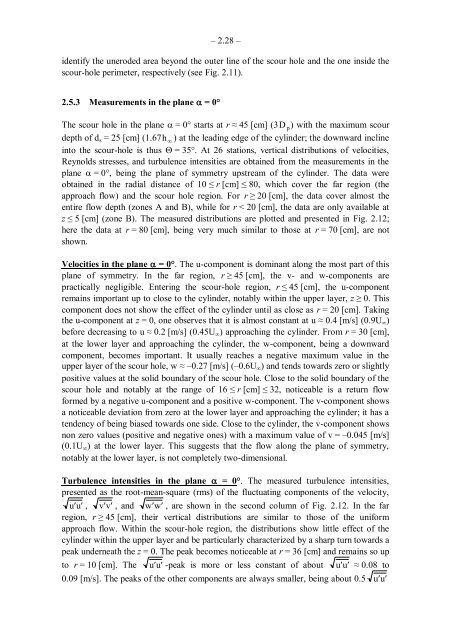Create successful ePaper yourself
Turn your PDF publications into a flip-book with our unique Google optimized e-Paper software.
– 2.28 –<br />
identify the uneroded area beyond the outer line of the scour hole and the one inside the<br />
scour-hole perimeter, respectively (see Fig. 2.11).<br />
2.5.3 Measurements in the plane � = 0°<br />
The scour hole in the plane � = 0° starts at r ≈ 45 [cm] (3D p ) with the maximum scour<br />
depth of ds = 25 [cm] (1.67h � ) at the leading edge of the cylinder; the downward incline<br />
into the scour-hole is thus � = 35°. At 26 stations, vertical distributions of velocities,<br />
Reynolds stresses, and turbulence intensities are obtained from the measurements in the<br />
plane � = 0°, being the plane of symmetry upstream of the cylinder. The data were<br />
obtained in the radial distance of 10 ≤ r [cm] ≤ 80, which cover the far region (the<br />
approach flow) and the scour hole region. For r ≥ 20 [cm], the data cover almost the<br />
entire flow depth (zones A and B), while for r < 20 [cm], the data are only available at<br />
z ≤ 5 [cm] (zone B). The measured distributions are plotted and presented in Fig. 2.12;<br />
here the data at r = 80 [cm], being very much similar to those at r = 70 [cm], are not<br />
shown.<br />
Velocities in the plane � = 0°. The u-component is dominant along the most part of this<br />
plane of symmetry. In the far region, r ≥ 45 [cm], the v- and w-components are<br />
practically negligible. Entering the scour-hole region, r ≤ 45 [cm], the u-component<br />
remains important up to close to the cylinder, notably within the upper layer, z ≥ 0. This<br />
component does not show the effect of the cylinder until as close as r = 20 [cm]. Taking<br />
the u-component at z = 0, one observes that it is almost constant at u ≈ 0.4 [m/s] (0.9U∞)<br />
before decreasing to u ≈ 0.2 [m/s] (0.45U∞) approaching the cylinder. From r = 30 [cm],<br />
at the lower layer and approaching the cylinder, the w-component, being a downward<br />
component, becomes important. It usually reaches a negative maximum value in the<br />
upper layer of the scour hole, w ≈ –0.27 [m/s] (–0.6U∞) and tends towards zero or slightly<br />
positive values at the solid boundary of the scour hole. Close to the solid boundary of the<br />
scour hole and notably at the range of 16 ≤ r [cm] ≤ 32, noticeable is a return flow<br />
formed by a negative u-component and a positive w-component. The v-component shows<br />
a noticeable deviation from zero at the lower layer and approaching the cylinder; it has a<br />
tendency of being biased towards one side. Close to the cylinder, the v-component shows<br />
non zero values (positive and negative ones) with a maximum value of v = –0.045 [m/s]<br />
(0.1U∞) at the lower layer. This suggests that the flow along the plane of symmetry,<br />
notably at the lower layer, is not completely two-dimensional.<br />
Turbulence intensities in the plane � = 0°. The measured turbulence intensities,<br />
presented as the root-mean-square (rms) of the fluctuating components of the velocity,<br />
u �� u ��,<br />
v �� v ��,<br />
and w ��w<br />
��,<br />
are shown in the second column of Fig. 2.12. In the far<br />
region, r ≥ 45 [cm], their vertical distributions are similar to those of the uniform<br />
approach flow. Within the scour-hole region, the distributions show little effect of the<br />
cylinder within the upper layer and be particularly characterized by a sharp turn towards a<br />
peak underneath the z = 0. The peak becomes noticeable at r = 36 [cm] and remains so up<br />
to r = 10 [cm]. The u �� u ��-peak<br />
is more or less constant of about u �� u �� ≈ 0.08 to<br />
0.09 [m/s]. The peaks of the other components are always smaller, being about 0.5 u �� u<br />
��

















